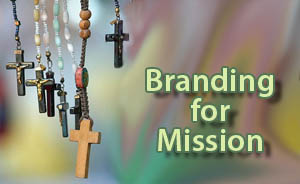 We’ve discussed the need to look over your shoulder and include your denomination’s regional offices and other congregations.
We’ve discussed the need to look over your shoulder and include your denomination’s regional offices and other congregations.
We’ve discussed how branding helps your members understand their mission.
Now you are ready for outreach to your community.
A typical starting point in any branding campaign is to craft a mission statement.
The mission of every church is defined in the Bible.
Therefore go and make disciples of all nations, baptizing them in the name of the Father and of the Son and of the Holy Spirit, and teaching them to obey everything I have commanded you. —Matthew 28:19-20
There are other verses you can focus on, but this one encompasses a great deal.
The task of each congregation is to refine this directive in a way that will keep your people on a chosen track of implementation.
We all know how easy it is to become distracted from our mission. This is a special challenge for small congregations. We small churches are so busy putting out fires that it is easy for us to lose our way!
There is a tendency to measure all congregations against some standard that, frankly, isn’t very well-defined. It may be a typical suburban church or a church with a well-known pastor. It is never the small church — although we outnumber larger churches!
This can be a shock to a small congregation’s self-confidence. There the driving force is often a dedicated and changing staff of lay people, who juggle uncompensated mission and ministry with work lives.
In defining your mission be true to yourself. If you are a family church, concentrate on the values of a family church—the warmth, the intimacy, the ability for newcomers to assimilate quickly. If you are a pastoral church you might have an emphasis that is a “trademark” of your leadership. That might be reaching a particular ethnic group or operating a daycare program. Your mission should express whatever binds you together as a people.
Mission is a huge task and one that was never intended to be performed solo. (2×2!) The task of congregations is to answer the question How? (We’ve talked about the Why? question before.)
How will your group of people—with all the things you have going for you (taking into account your limitations)—fulfill Christ’s directive? In short:
How do you reach, how do you preach, and how do you teach?
You might start by asking each member this question. Their answers should help shape the “official” mission statement. Having been included in the process, they will own the mission.
Once a mission statement is adopted put it to work.
- Feature it on your web site, on your stationery, and on your signage.
- Hold a service to celebrate the adoption of a mission statement.
- Invite several people to speak to the mission. Do this regularly!
- Have a pin made or give out refrigerator magnets featuring your statement.
- Make a congregational T-shirt featuring your mission. Declare T-shirt events (service projects, for example) when members should come in “uniform.”
- Hang a banner over your door. (Outside where people can see it.)
- Begin every service or meeting by reciting your mission together.
- Write a press release and send it to local papers.
Keep your mission front and center.
But remember, your mission can change. Review it every few years to make sure you can still live up to its directive, and that, in focusing on it, you are not ignoring new opportunities. Actually, we live in such a fast-changing world that proclaiming a special mission emphasis each year might not be a bad idea. (Next post!)





